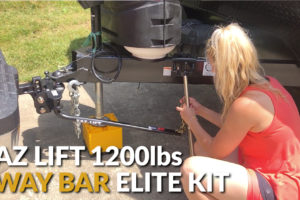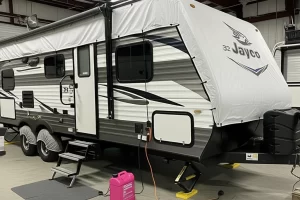If you’ve ever felt your trailer shimmy in the wind or sway when a semi blows past, you know how nerve-wracking towing can be. That’s where sway bars come in—and let me tell you, after years of family RV trips and weekend getaways, I would not tow without them.
We use the EAZ LIFT sway bar system on our travel trailer, and honestly, it’s been a game changer. It adds a layer of control and peace of mind that’s hard to overstate. It might not be the flashiest upgrade to your rig, but it just might be the most underrated.
What Do Sway Bars Actually Do?
Sway bars (also called weight distribution hitches with sway control) help distribute the weight more evenly between your trailer and tow vehicle, and reduce the side-to-side motion that can happen from wind, uneven roads, or sharp turns. It’s like having a co-pilot that keeps everything steady behind you.
The Advantages of Using Sway Bars
1. Peace of mind.
This is my number one. Towing is stressful enough—kids asking for snacks, traffic, weather—but knowing the trailer is secure adds a level of comfort that lets me focus on the road. It’s one less thing to worry about.
2. Better control and stability.
With sway bars, steering feels more responsive and predictable. The trailer doesn’t feel like it’s pulling or pushing you around. The whole setup just feels… smoother.
3. Safety in windy conditions or when passing trucks.
Crosswinds and large vehicles are a lot less scary with sway control. It reduces that “tail wagging the dog” effect that can happen without sway bars.
4. Tire and suspension protection.
Spreading the weight evenly helps reduce wear on your tires and suspension, saving you money in the long run.
The Disadvantages (They’re Minor, But Worth Knowing)
1. Setup takes a little effort.
Installing the weight distribution hitch and sway bars does take some initial setup. It’s not rocket science, but it’s a bit of a process the first time.
2. Adds a few minutes to set-up and tear-down.
Attaching and detaching the sway bars is an extra step during camp arrival and departure. It’s not a deal-breaker, especially given the benefits, but it’s a factor to plan for.
3. Potential for noise.
Some sway bar systems can be noisy when turning, especially in tight spaces like campgrounds. (Ours is fairly quiet, but it’s something to be aware of.)
4. Not all sway bars are created equal.
Which brings us to the next point…
How to Choose the Right Sway Bar System
The key to sway bar success is picking the right setup for your tow vehicle and trailer combo. Here’s what to consider:
Weight Rating:
Your sway bar system should match the gross trailer weight (GTW) and tongue weight (TW) of your trailer. Too small, and it won’t do the job. Too big, and it may make for a rough ride.
Type of Trailer:
Travel trailers with higher profiles (like ours) are more susceptible to sway. If you have a pop-up or low-profile trailer, sway control might be less critical—but still helpful.
Tow Vehicle Size:
A heavy-duty truck can handle sway better than a small SUV. But even large vehicles benefit from sway control when towing longer trailers.
Terrain and Travel Style:
If you’re frequently on highways, mountain passes, or wind-prone routes, sway bars are a must. Weekend campers might get by without them—but once you try them, it’s hard to go back.
Our Pick: EAZ LIFT Sway Control Hitch
We’ve been using the EAZ LIFT sway bar system, and it hits the sweet spot for performance, price, and ease of use. It includes a weight distribution hitch and adjustable sway control that you can dial in to your comfort.
Whether you’re new to RV life or a seasoned traveler, sway bars are one of those upgrades that make every mile smoother and every trip safer. It might not be the flashiest piece of gear in your camping arsenal—but it just might be your favorite.




